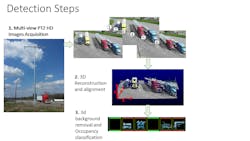Knowing if a truck parking lot is full should be easy, but it isn't.
Transportation experts have tried several different ways to tell truckers when there's a place for them but they all have shortcomings. For example, simply counting vehicles entering and exiting a parking area by using a 'trip wire' type set up – either a camera or sensors in the pavement – turns out to suffer from small miscalculations that can accumulate to large errors over a several week period.
The current state of the art is pavement sensors embedded in parking spaces, but it, too, has shortcomings, according to Nikos Papanikolopoulos, principal investigator for the Minnesota Truck Parking Availability System which uses a radically different method to count open spaces: Digital cameras attached to 3D software. "Let’s suppose that you have a vehicle that is parked sideways and covers two spots. If you have an embedded sensor, it’s going to tell you there’s an empty spot but in reality you have no empty spots." This can occur if drivers cannot see parking lines because of poor visibility or snow on the ground.
Another disadvantage of pavement sensors is that the parking area has to be broken up to install the sensors which can weaken the pavement making it less able to handle seasonal variations such as cold, heat and ice. "What this means is that it incurs another maintenance budget to do repairs," says Ted Morris, a Senior Research Engineer with the Department of Computer Science at the University of Minnesota, and a colleague of Papanikolopoulos on the parking project.
Their goal was to find a highly accurate, non-intrusive, low-maintenance way of counting empty truck spaces and they believe they've found it with digital cameras suspended above a parking area to monitor space availability. So far, the system has been successfully tested along I-94 in Minnesota at three public rest areas - Big Spunk Lake, Enfield and Elm Creek - with an accuracy rate of better than 95 percent. (See: Seeking solutions to the truck parking shortage, Fleet Owner, Dec. 7, 2012) The team is convinced that the system works well enough to go commercial, and they're eager to expand it to additional parking lots both public and private.
Put simply, the camera software knows the parking lot geometry and detects open spaces based on 3-dimensional volume. "Generally, if there's enough of an open space [to fit a truck] we say it's vacant," says Morris. The information can then be sent to truckers via smartphones, a special reader in their cabs or on highway signs.
A huge benefit of this technology is that a lot can change its parking allocations without doing anything but redrawing white lines. "If the lot geometry and the way the spaces are allocated changes," says Morris, "you would have to dig out the ground-embedded structures and then reinstall them. With our system, you just simply map in a new geometry that the cameras use for detection."
The drawbacks? According to Papanikolopoulos, some parking areas don't have high poles upon which to mount the cameras. This is the often the case with public rest areas. "It's different for private rest areas. [Private lots often have high poles that carry safety lighting.] We’re in discussions with a large private operator where we can do this for far, far less because all of the infrastructure [high poles or buildings] is there. We just need to mount cameras." Cameras cost between $1,000 and $3,000.
He adds: "The biggest handicap we have is that we are a university team. Although we have a partner in a major consulting firm in the area, people view us and think, 'is this really a hardened system?' We say that it's been working for almost three years. It's highly accurate, extremely low maintenance, and everything is commercially available off the shelf. There is no specialized hardware… I think the biggest problem we’re facing is how to convince some of people that this really a different way of looking at this important problem."
The project team includes the Minnesota Department of Transportation, University of Minnesota and the American Transportation Research Institute. The team has filed a patent on their system so they can commercialize it.
About the Author

Larry Kahaner
Larry Kahaner is an author, journalist, and former FleetOwner contributor.
